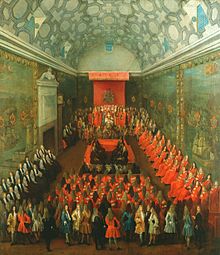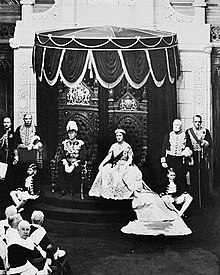King-in-Parliament: Difference between revisions
Trackratte (talk | contribs) Remove recent addition, again, this only pertains to the British system and practice and not the concept itself, which is the topic of this article. Specifics as to British or individual state practices belong on those specific Wiki articles. |
Trackratte (talk | contribs) ce, change wiki link to be more specific to the office holder vice wider institution |
||
| Line 3: | Line 3: | ||
[[File:HM Queen Victoria Opening Parliament.jpg|thumb|[[Queen Victoria]] Opening Parliament, 1845, by Alexander Blaikley. The Queen-in-Parliament comprises "the Queen sitting on her Throne with the Lords of Parliament sitting before her and the Commons standing at the Bar."<ref name=”Jennings” />]] |
[[File:HM Queen Victoria Opening Parliament.jpg|thumb|[[Queen Victoria]] Opening Parliament, 1845, by Alexander Blaikley. The Queen-in-Parliament comprises "the Queen sitting on her Throne with the Lords of Parliament sitting before her and the Commons standing at the Bar."<ref name=”Jennings” />]] |
||
In the [[Westminster system]], the '''King-in-Parliament''' ('''Queen-in-Parliament''' during the reign of a queen |
In the [[Westminster system]], the '''King-in-Parliament''' ('''Queen-in-Parliament''' during the reign of a queen) is a constitutional law concept used within [[Commonwealth realm]]s that refers to the [[monarch]] in its legislative role, acting with the [[advice and consent]] of the parliament (including, if the parliament is [[Bicameralism|bicameral]], both the [[lower house]] and [[upper house]]). [[Bill (proposed law)|Bills]] passed by the houses are sent to the sovereign or their representative (such as the [[governor-general]], [[lieutenant-governor]], or [[governor]]), for [[Royal Assent|royal assent]] in order to enact them into laws as [[Act of Parliament|acts of Parliament]]. An Act may also provide for [[secondary legislation]], which can be made by executive officers of the Crown, although subject to the simple approval or disallowance by parliament.{{Citation needed|date=April 2024}} |
||
==Parliamentary sovereignty== |
==Parliamentary sovereignty== |
||
Revision as of 17:24, 10 April 2024

In the Westminster system, the King-in-Parliament (Queen-in-Parliament during the reign of a queen) is a constitutional law concept used within Commonwealth realms that refers to the monarch in its legislative role, acting with the advice and consent of the parliament (including, if the parliament is bicameral, both the lower house and upper house). Bills passed by the houses are sent to the sovereign or their representative (such as the governor-general, lieutenant-governor, or governor), for royal assent in order to enact them into laws as acts of Parliament. An Act may also provide for secondary legislation, which can be made by executive officers of the Crown, although subject to the simple approval or disallowance by parliament.[citation needed]
Parliamentary sovereignty

By the mid-16th century, it had been established that the "King in Parliament" held supreme legislative authority in England.[2] However, this phrase was subject to two competing theories of interpretation.[2][3][4] The Royalist view interpreted the phrase as "King, in Parliament"; that is, the King acting with the consent of the Lords and Commons, but ultimately exercising his own sovereign authority.[3] The Parliamentarian view was that legislative authority was exercised by the "King-in-Parliament”, a composite institution of the King, Lords, and Commons acting together.[3]
As described by Jeffrey Goldsworthy, "The question that divided them was whether [the] final, unchallengeable decision-maker was the king alone, or the King, Lords, and Commons in parliament."[2] The dispute had implications for the ability of Parliament to limit the monarch’s powers, or "the supremacy of the King in Parliament over the King out of Parliament."[5] The clash between the Royalist and Parliamentarian views continued through the 16th century and much of the 17th, and was a factor in the English Civil War (1642-1651) and the execution of Charles I (1649).[3][6] During the British Interregnum (1649-1660), Parliament ruled without a King.
The Parliamentarian position ultimately prevailed with the Glorious Revolution (1688-89) and subsequent passing of the Bill of Rights 1689, which significantly limited the powers of the monarch, including removing prerogative powers to suspend or dispense with statues.[7]
Composite body

According to constitutional scholar A.V. Dicey, "Parliament means, in the mouth of a lawyer (though the word has often a different sense in ordinary conversation), the King, the House of Lords, and the House of Commons; these three bodies acting together may be aptly described as the 'King in Parliament,' and constitute Parliament."[8] Legal philosopher H. L. A. Hart wrote that the Queen-in-Parliament is “considered as a single continuing legislative entity”.[9]
Constitutional scholar Ivor Jennings described the Queen-in-Parliament as "a purely formal body consisting of the Queen sitting on her Throne with the Lords of Parliament sitting before her and the Commons standing at the Bar."[1] This formal gathering was historically the only process by which legislation could be enacted. The Royal Assent by Commission Act 1541 allowed Lords Commissioners to stand in for the monarch, and the Royal Assent Act 1967 allowed legislation to be enacted by pronunciation, without a physical gathering. The assembling of the King, Lords, and Commons as the King-in-Parliament is now "notional rather than real",[10] only occurring ceremonially at the annual State Opening of Parliament.[1][11]
The composition of the King-in-Parliament is reflected in the enacting clause of acts of Parliament: "Be it enacted by the King's most Excellent Majesty, by and with the advice and consent of the Lords Spiritual and Temporal, and Commons, in this present Parliament assembled, and by the authority of the same, as follows..." The phrasing is different when the bill is passed under the provisions of the Parliament Acts 1911 and 1949, without the consent of the House of Lords.
Balance of power within the King-in-Parliament

The concept of the King-in-Parliament holding supreme legislative authority is a core tenet of the Constitution of the United Kingdom.[12] As a concept, legislative authority being exercised by the King-in-Parliament is compatible with different distributions of power among its three components.[2][13] This allowed for increasing limitations on the monarch’s influence by Parliament over the 18th and 19th centuries.[14] The Parliament Acts 1911 and 1949 allow money bills to be passed against the wishes of the House of Lords, but such legislation can still be understood in a constitutional sense to be an act of the King-in-Parliament, that is by the King, Lords, and Commons acting jointly.[15]
Rules and procedures
In order to act as the King-in-Parliament, the individual components must act according to their established rules and procedures. The individuals involved must be "constituted as a public institution qua Parliament (on the basis of some rules and under certain circumstances)" in order to "[enjoy] the power to legislate as 'the Queen in Parliament' i.e., the ultimate legislature."[16] This creates a potential paradox when determining Parliament’s ability to modify its own rules or composition.[16]
Other parliaments

Many Commonwealth countries have parliaments based on the Westminster model.
Section 17 of Canada's Constitution Act, 1867 establishes the Parliament of Canada as the legislative authority for the country, defining it as consisting of "the Queen [or King], an Upper House styled the Senate, and the House of Commons." This three-part composition is "along the lines of the British model of legislative sovereignty vesting in the Queen-in-Parliament".[17]
Canadian acts of Parliament contain the following enacting clause: "Now, therefore, His Majesty, by and with the advice and consent of the Senate and House of Commons of Canada, enacts as follows..." Other Commonwealth parliaments, including the Parliament of Tuvalu and the provincial Parliament of Quebec, simply state that the enactment is done by "parliament".[citation needed]
Legal scholar Paul McHugh describes both Canada and New Zealand as having "a crisis of constitutional identity" in the later 20th century, finding "the old Whig narrative of an absolute sovereign self (the Crown in Parliament)" to be inadequate. The Canadian response was to "not seek to refurbish a historical order so much as to fundamentally reorder it by adopting the Charter of Rights and Freedoms limiting the power of government, the Crown in Parliament (federal and provincial) included."[12] By contrast, in New Zealand, the response was "[i]nstead of limiting an almighty Crown in Parliament, it reconstituted that Parliament on an electoral model of proportional representation."[12]
References
- ^ a b c Jennings, Ivor (1967). The Queen's Government. Penguin. pp. 66–68.
- ^ a b c d Goldsworthy, J.D. (2000). "Chapter 2: The Development of Parliamentary Sovereignty". In Dickinson, H.T.; Lynch, M. (eds.). The Challenge to Westminster: Sovereignty, Devolution and Independence. Tuckwell. pp. 12–21.
- ^ a b c d Goldsworthy, J.D. (1999). The Sovereignty of Parliament: History and Philosophy. The Sovereignty of Parliament: History and Philosophy. Clarendon Press. p. 9, 53, 65-69. ISBN 978-0-19-826893-2. Retrieved 6 April 2024.
- ^ Edlin, Douglas E. "Rule Britannia". University of Toronto Law Journal. 52 (Summer, 2002): 313.
- ^ Phillips, O.H.; Jackson, P. (1987). Constitutional and Administrative Law. Sweet & Maxwell. p. 45. ISBN 978-0-421-35030-4.
- ^ Davis, Louis B.Z. "Review of the Fundamentals: The Source of the Government's Authority and the Justification of Its Power, in Terms of Constitutional Morality". Journal of Parliamentary and Political Law. 8 (August, 2014): 489.
- ^ Horsman, Karen; Morley, Gareth (2023). "§ 1:3. The Development of the English/British Monarchy". Government Liability: Law and Practice. Thomson Reuters.
- ^ Dicey, A.V. (1915). Introduction to the Study of the Law of the Constitution (8th ed.). London: Macmillan. p. 3.
- ^ Hart, H.L.A. (1972). The Concept of Law. Clarendon law series. Clarendon Press. p. 66. Retrieved 6 April 2024.
- ^ Brazier, R. (1998). Constitutional Reform. Oxford University Press. p. 56. ISBN 978-0-19-876524-0. Retrieved 6 April 2024.
- ^ Adonis, A. (1993). Parliament Today. Politics today. Manchester University Press. p. 3. ISBN 978-0-7190-3978-2. Retrieved 6 April 2024.
- ^ a b c McHugh, P.G. "Tales of Constitutional Origin and Crown Sovereignty in New Zealand". University of Toronto Law Journal. 52 (Winter, 2002): 69.
- ^ Fenwick, H.; Phillipson, G.; Williams, A. (2020). Text, Cases and Materials on Public Law and Human Rights. Taylor & Francis. ISBN 978-1-135-07133-2. Retrieved 6 April 2024.
- ^ Rowe, Malcolm. "The History of Administrative Law". Canadian Journal of Administrative Law & Practice. 34 (March, 2021): 87.
- ^ Ekins, Richard; Gee, Graham (2022). "Ten Myths about Parliamentary Sovereignty". In Horne, A.; Thompson, L.; Yong, B. (eds.). Parliament and the Law. Hart Studies in Constitutional Law. Bloomsbury Publishing. p. 299. ISBN 978-1-5099-3411-9. Retrieved 6 April 2024.
- ^ a b Eleftheriadis, Pavlos. "Parliamentary Sovereignty and the Constitution". Canadian Journal of Law and Jurisprudence. 22 (July, 2009): 267.
- ^ Newman, Warren J. "Some Observations on the Queen, the Crown, the Constitution, and the Courts" (PDF). Centre for Constitutional Studies. Retrieved 6 April 2024.
